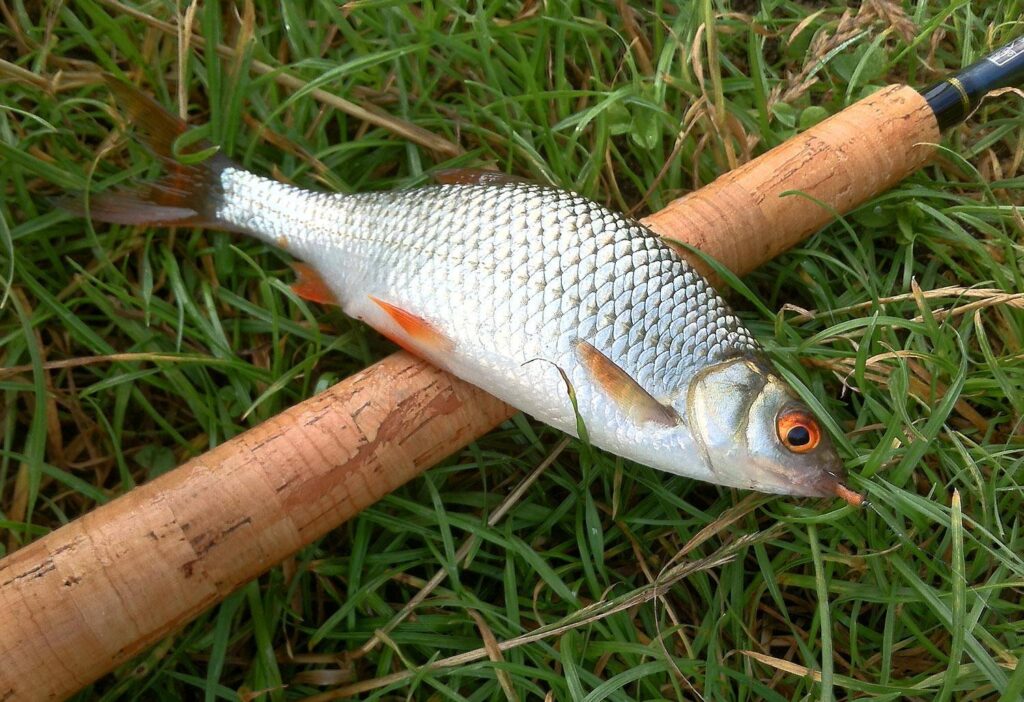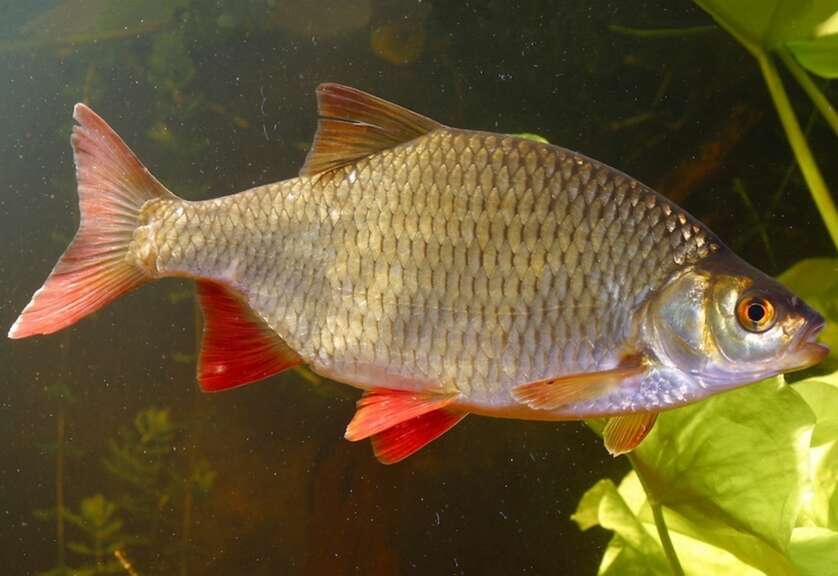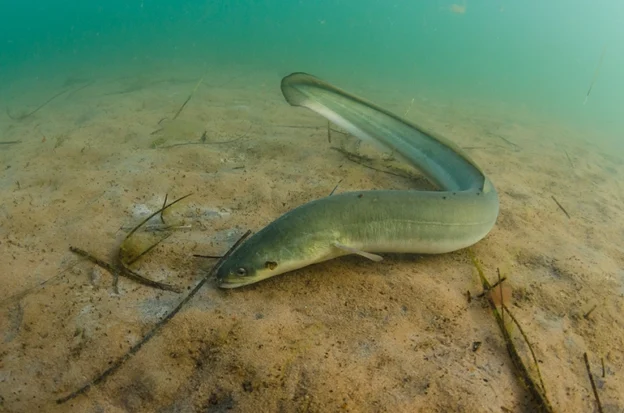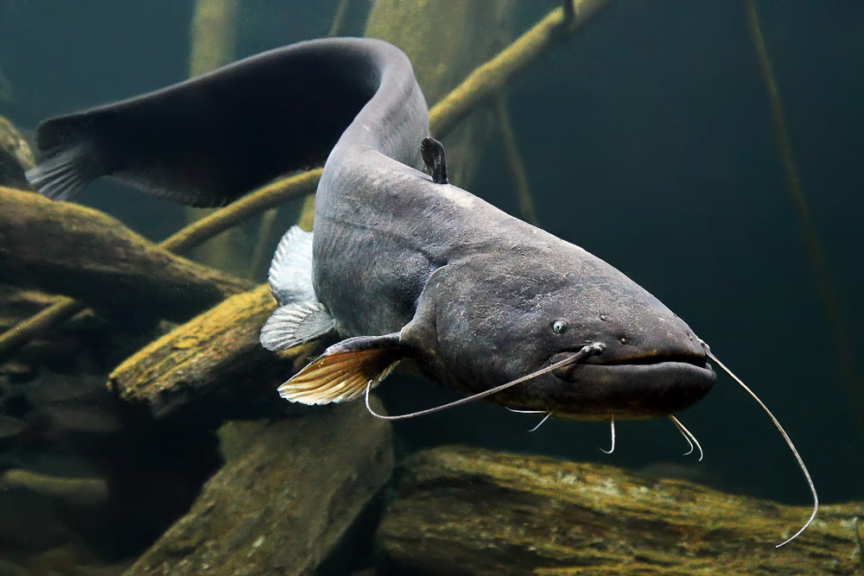Grunt is a small, bottom-dwelling fish belonging to the group of grunts (Gobiidae) family. This fish originates from the Black and Caspian Sea basins, but in recent decades it has spread to Lithuanian waters. Therefore, the grunt is now considered an invasive species in our country. At first glance, it is an unimpressive fish, but it is still surprising in its resilience, fecundity and abundance.
What does a groundhog look like?
The appearance of the grunt reflects its bottom-dwelling lifestyle and helps it camouflage itself in its environment. Its body is usually brownish-gray with dark spots, making it almost invisible among rocks and algae. The body length rarely exceeds the length of the gills, and adult individuals grow to about 20–23 cm. The grunt is characterized by a large, blunt head with high-set eyes and a wide mouth. There is also a bright black spot on the first dorsal fin, which gives away the identity of this fish. The grunt's pelvic fins are developed into suckers, allowing the fish to firmly attach to rocks on the bottom. In addition, the grunt does not have a swim bladder, so it constantly sticks to the bottom. During spawning, males darken and can become almost black, while females remain lighter and smaller.

Lifestyle
The grunt is a bottom dweller, so it prefers rocky or sandy bottoms, where it can find a hiding place among stones or plants. It is found from shallow bays of the Baltic coast to river mouths and freshwater bodies, as it is suitable for various water salinities. In addition, the grunt tolerates large temperature fluctuations - it can live in water from almost -2 °C to +30 °C. Also, these fish are not afraid of polluted water and tolerate low oxygen levels - this helps them survive even in harsh environments.
For all these reasons, this invasive creature easily adapts to new waters and reproduces rapidly. It is an extremely predatory fish - it eats practically everything that moves on the bottom and fits into its jaws. The prey of the grunt consists of mollusks (mussels, snails), worms, crustaceans, insect larvae and small fish and their eggs. With such voraciousness, grunts can devastate water bodies and eat the eggs and fry of other fish. However, these small grunts boldly attack even larger fish, defending their hiding place.
Grundles often congregate in large numbers in a small area, but each one usually has its own hiding place. These fish do not migrate far and usually spend their entire lives in the same stretch of coast. Due to intensive breeding, grundles only live for about 4-5 years. Although grundles are harmful to local ecosystems, they have become prey for larger predatory fish (such as starlings, for perch, for pike) and fish-eating birds – cormorants, divers, etc., so these invasive predators are partly naturally regulated by local predators.
How does a gudgeon spawn?
These fish begin spawning in the spring (April) when the water warms up and continue until the end of summer, spawning several times per season. The male occupies a small territory during spawning and builds a nest under a rock or other crevice in the bottom. He then attracts several females, and they lay their eggs in that hiding place on a hard surface. Several females can lay several thousand eggs in one nest, so the clutches of grunts are very large. Each female lays hundreds or even thousands of eggs in one spawning, so this species can rapidly increase its population.
After spawning, the male protects and ventilates the eggs, providing them with oxygen for development. During the spawning period, the male does not eat at all and hardly leaves the nest until the fry hatch - the young usually hatch after about 1.5-2 weeks (depending on the water temperature). Unfortunately, after spawning, many males die from exhaustion, so their lifespan is very short. In addition, males can make unique bubbling sounds when defending the nest, which scare away intruders - such "growling" sounds of grunts have been recorded in scientific studies.
Distribution of the grunt
The natural homeland of the grunt is the Ponto-Caspian region (the basins of the Black, Azov and Caspian Seas), and for a long time this species lived only there. However, at the end of the 20th century, this fish began to spread outside its native range. In 1990, it was first observed in the Baltic Sea (in the Gdansk Bay of Poland). Since then, the grunt has spread throughout the Baltic Sea - today it is widespread along many Baltic Sea coasts (Poland, Lithuania, Latvia, Estonia, Finland, Sweden, Germany) and has penetrated into inland freshwater bodies. In addition to the Baltic Sea, the grunt is also found as an invasive species in other regions.
In the 1980s, grunts appeared in the Great Lakes of North America, where they successfully adapted and multiplied rapidly. Interestingly, in the Great Lakes, grunts eat invasive mollusks. Although this somewhat reduces the number of these pests, the grunts themselves have become a serious challenge to the local ecosystem there. Grunts have also entered many European river and lake systems through ship channels. It is believed that in new territories, grunts gain an advantage because they lack natural enemies or diseases. In places, grunts have become one of the most abundant fish.
How the grunt appeared in Lithuania
Ships brought grunts with ballast water, and these fish were first observed in Lithuania in 2002 near the port of Klaipėda. Since then, this invasive species has rapidly spread along the Lithuanian coastline and soon reached the Curonian Lagoon. As is typical for invasive species, there was an “explosion” in the grunt population around 2012. At that time, coastal fishermen could catch even several buckets of these fish per day. In recent years, grunts have also been found in the country's inland waters - they have spread to the Nemunas Delta, the Neris River, and were recently even caught in the Nevėžis River near Kaunas. This indicates that this invasive fish is continuing to expand its range in Lithuania. The grunt is currently one of two fish officially included in the Lithuanian list of invasive species, therefore, great attention is paid to regulating its abundance.
Grunt fishing
In recent years, fishing for grunts has become extremely popular on the coast, because catching these fish is easy and fun. In the spring, when grunts are particularly active, hundreds of fishermen gather on the Palanga bridge. The fishing technique is simple - a small fishing rod with a hook and dropping the bait on the bottom are enough. Grunts grab practically any bait, so there is no need for sophisticated baits. Fishermen use shrimp, worms, pieces of chicken as bait, and after catching the first grunt, they cut it up and use it as bait. Aggressive fish are not picky at all; they even bite on a cigarette butt. Often, a couple of hours are enough to catch a full bucket. Once you catch a grunt, it is advisable not to release it back - since it is an invasive species, there are no restrictions on its capture. Fishermen even joke: "kill a gudgeon - save nature", emphasizing that every gudgeon killed helps protect local fish species.

Culinary properties
Previously, grunts were poorly appreciated - after catching these unsightly fish the size of a pinhead, fishermen would simply throw them away. However, in recent years, as the grunt population has massively increased, people have started to eat them and have become convinced that they are a very tasty fish. The meat of the grunts is tender and white, without many small bones - as fishermen say, "white as cod". These fish are fried, smoked, marinated, boiled into fish soup or stewed with vegetables. Fried grunts resemble small sea fish and are especially popular for their crispy texture. In addition, grunts are easy to prepare - when cleaning them, there is almost no need to shave the scales, the fish has few bones and a lot of large white meat. Due to the large supply, these fish can be purchased very cheaply at markets, and seaside cafes are already serving grunt dishes.




